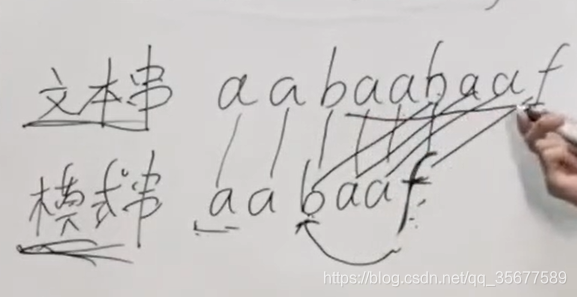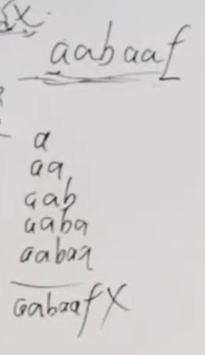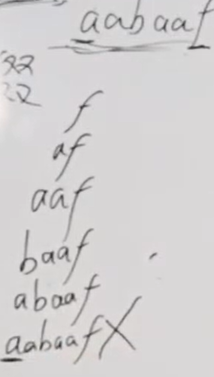本文共 822 字,大约阅读时间需要 2 分钟。
1、KMP算法的用途
KMP算法是用来找出a字符串中的b字符串,其中a叫做文本串,b叫做模式串
KMP算法是如何在a文本串中找出b模式串的呢?
如图所示:当将模式串与文本串一一进行对比时,如果出现匹配不上的情况时,模式串找到b继续搜索,那么如何能够找到b呢?

2、前缀表
要找到b就要先立即前缀表的概念,如下图所示:模式串除去最后一个字母,然后顺序排列就是其前缀,注意不包含尾字母。

3、后缀表
模式串除去首位一个字母,然后顺序排列就是其前缀,注意不包含首字母。

4、求模式串的最长相等前后缀
观察模式串,是否有相等的前后缀,然后观察长度,找到长度的最大值,此时便可以得到前缀表:010120

然后利用前缀表的最长长度去找b这个值。因为索引是从0开始的,所以最长的前缀的后一个字母的坐标就是最长前缀的长度。

然后从b开始向后匹配,我们就可以完成匹配的过程。
那么具体怎么操作呢?
首先将前缀表达式装入一个叫做next的数组
然后对next中的元素统一执行减一操作:
执行操作完成后next就是前缀表。

求next数组的步骤:
1、初始化next数组
2、求出前后缀相同的情况和前后缀不同的情况
3、更新next数组
初始化next数组
首先来理解一下的概念,当目前的next数组是1的时候,在什么时候它会变成2?

仔细思考过后,就需要判断下标为6的那个值是否是B如果是B那对对应位置的前缀表就变成2。
那么如何让程序执行这个思考过程呢?
我们可以看到下标为5的地方其前缀表的值是1,那么由于前缀表的值也是其对应的相同前缀的最后一个值的下一个值的坐标,因此此时坐标1下的值就用来判断是否和坐标6下的值是否相等。

定义相同前后缀的后一个值的坐标为len,由上方我们的分析可知,len=1;
len的值说的是最大相同前后缀的长度。
那么就有如下的代码来计算len的值

那么如果最大相同前后串的下一个值不等于i的下一值的时候,我们应该怎么办?
如下图:

转载地址:http://chgjz.baihongyu.com/